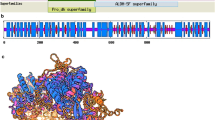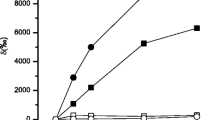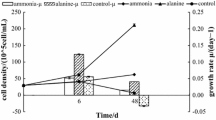Abstract
Cells ofPhaeodactylum tricornutum Bohlin develop the ability to take up L-lysine when they are deprived of nitrogen (illuminated in nitrogen-free medium), carbon (incubated in darkness) or both. Cells with a developed uptake system take up and accumulate lysine in an unchanged form. Uptake occurs under either aerobic or anaerobic conditions and is dependent on the presence of sodium+ ions (K s Na +=,ca. 10 mM). Some potassium+ ions are necessary for uptake, presumably within the cells, but with potassium+-replete cells, increasing K+ concentration depresses lysine uptake. The lysine-uptake porter also transports L-arginine.K s values are about 1.5 μM for lysine and 0.5 μM for arginine. It is, however, possible that the uptake system developed by incubating cells in darkness differs from that produced in light; it shows a pronounced pH optimum at pH 8.5, whereas the activity of the light-developed system declines from pH 6.5 to pH 9.0 and correlates well with the concentration of lysine+. The uptake system developed in darkness may also have a higher affinity for lysine. Lysine uptake is not inhibited by 1 mM concentrations of nitrate, nitrate, ammonium, or urea nor by similar concentrations of amphoteric or acidic amino acids.
Similar content being viewed by others

Literature cited
Bliss, C. I. and A. T. James: Fitting the rectangular hyperbola. Biolmetrics22, 573–602 (1966)
Braven, J., R. Evens and E. I. Butler: Amino acids in sea water. Chemy Ecol. (U.K.)2, 11–21 (1984)
Butler, E. I., S. Knox and M. I. Liddicoat The relationship between inorganic and organic nutrients in sea water. J. mar. biol. Ass. U.K.59, 239–250 (1979)
Cho, B.-H. and E. Komor: Mechanism of arginine transport inChlorella. Planta163, 23–29 (1984)
Clark, M. E., G. A. Jackson and W. J. North: Dissolved free amino acids in Southern California coastal waters. Limnol. Oceanogr.17, 749–758 (1972)
Cresswell, R. C., and P. J. Syrett: Uptake of nitrate by the diatomPhaeodactylum tricornutum. J. exp. Bot.32, 19–25 (1981)
Dawson, R. M. C., D. C. Elliott, W. H. Elliott and K. M. Jones: Data for biological research, 2nd ed. 654 pp. Oxford: University Press 1969
Flynn, K. J. and P. J. Syrett: Development of the ability of take up L-lysine by the diatomPhaeodactylum tricornutum. Mar. Biol.90, 159–163 (1986)
Hellebust, J. A.: The uptake and utilization of organic substances by marine phytoplankters. Occ. Publs Inst. mar. Sci. Univ. Alaska Coll.1, 225–256 (1970)
Jørgensen, N. O. G., K. Mopper and P. Lindroth: Occurrence, origin and assimilation of free amino acids in an estuarine environment. Ophelia (Suppl.)1, 179–192 (1980)
Kirk, D. L. and M. M. Kirk: Amino acid and urea uptake in ten species ofChlorophyta. J. Phycol.1, 198–203 (1978)
Liu, M. S. and J. A. Hellebust: Uptake of amino acids by the marine centric diatomCyclotella cryptica. Can. J. Microbiol.20, 1109–1118 (1974)
Lu, M. and G. C. Stephens: Demonstration of net influx of free amino acids inPhaeodactylum tricornutum using high performance liquid chromatography. J. Phycol.20, 584–589 (1984)
McLean, R. O., J. Corrigan and J. Webster: Heterotrophic nutrition inMelosira nummuloides, a possible role in affecting distribution in the Clyde Estuary. Br. phycol. J.16, 95–106 (1981)
North, B. B. and G. C. Stephens: Uptake and assimilation of amino acids byPlatymonas. II. Increased uptake in nitrogen-deficient cells. Biol. Bull. mar. biol. Lab., Woods Hole140, 242–254 (1971)
North, B. B. anc G. C. Stephens: Amino acid transport inNitzschia ovalis Arnott. J. Phycol.8, 54–68 (1972)
Ramos, E. H., L. C. De Bongioanni and A. D. M. Stoppani: Kinetics of L-(14C) leucine transport inSaccharomyces cerevisiae; effects of energy coupling inhibitors. Biochem. biophys. Acta599, 214–231 (1980)
Raven, J. A.: Nutrient transport in microalgae. Adv. microb. Physiol.21, 47–226 (1980)
Rees, T. A. V. and P. J. Syrett: The uptake of urea by the diatomPhaeodactylum. New Phytol.82, 169–178 (1979)
Shah, N. and P. J. Syrett: Uptake of guanine by the diatomPhaeodactylum tricornutum. J. Phycol.18, 579–587 (1982)
Stahl, E. (Ed.): Thin layer chromatography, 2nd ed. 1 041 pp. London: George Allen & Unwin Ltd. 1969
Thomas, E. L. and H. N. Christensen: Indications of spatial relationships among structures recognizing amino acids and Na+ at a transport receptor site. Biochem. biophys. Res. Commun.40, 277–283 (1970)
Thompson, J. and R. A. MacLeod Potassium transport and the relationship between intracellular potassium concentration and amino acid uptake by cells of a marine pseudomonad. J. Bact.120, 598–603 (1974)
Wheeler, P. A., B. B. North, M. M. Littler and G. C. Stephens: Uptake of glycine by natural phytoplankton communities. Limnol. Oceanogr.22, 900–910 (1977)
Wheeler, P. A., B. B. North and G. C. Stephens: Amino acid uptake by marine phytoplankters. Limnol. Oceanogr.19, 249–259 (1974)
Wright, S. A. and P. J. Syrett: The uptake of methylammonium and dimethylammonium by the diatomPhaeodactylum tricornutum. New Phytol.95, 189–202 (1983)
Author information
Authors and Affiliations
Additional information
Communicated by J. Mauchline, Oban
Rights and permissions
About this article
Cite this article
Flynn, K.J., Syrett, P.J. Characteristics of the uptake system for L-lysine and L-arginine inPhaeodactylum tricornutum . Mar. Biol. 90, 151–158 (1986). https://doi.org/10.1007/BF00569121
Accepted:
Issue Date:
DOI: https://doi.org/10.1007/BF00569121



